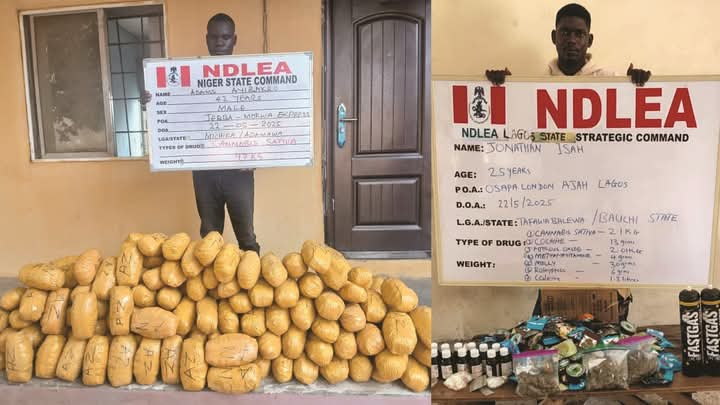The National Drug Law Enforcement Agency (NDLEA) has intercepted no fewer than six million opioid pills—including Tamol, Tapentadol, and Carisoprodol—and 332,000 bottles of codeine-based cough syrup at the Port Harcourt and Apapa ports.
The street value of the seizures is estimated at ₦6.52 billion.
At the Port Harcourt Ports Complex, Onne, NDLEA operatives, in a joint operation with Customs and other security agencies, uncovered six million opioid pills and 162,000 bottles of codeine syrup in two containers on May 19 and 20.
In a similar exercise at the Apapa Port, Lagos, 170,000 bottles of codeine syrup were discovered on May 22.
Meanwhile, four suspects—two British nationals and two Nigerians—were arrested at the Murtala Muhammed International Airport, Lagos, for attempting to smuggle 92 bags of Loud cannabis (51.1kg) into Nigeria.
Read Also: NDLEA nabs octogenarians, intercepts N3.2bn worth of drugs nationwide
The consignment, brought in by Mhizha Tatendra from Doha, was received at the airport car park by Ayedipe Adejuwon and his accomplices, Shonowo Imole and Ofuoma Ayobami.
A raid on their Lekki residence led to the recovery of over ₦3.8 million, 17,200 South African Rand, devices, and laughing gas canisters.
In other operations, NDLEA destroyed 75,000kg of skunk on 30 hectares in Cross River and seized over 2,000kg of the substance in Edo State. Additional arrests and seizures were recorded across Nasarawa, Kaduna, Bauchi, Yobe, Niger, and Lagos states.
Notable seizures include; 4,000kg of skunk in Keffi, Nasarawa (May 24), 45kg of skunk in Bauchi (May 21), 2kg of Colorado in Yobe (May 21), 97kg of cannabis in Niger (May 22), and multiple drug types in Lekki and Ibeju-Lekki, Lagos.
NDLEA also continued its War Against Drug Abuse (WADA) advocacy with sensitization activities in secondary schools across Katsina, Akwa Ibom, Ebonyi, Adamawa, and Kano, as well as a courtesy visit to the Sarkin Fulani of Lagos.
NDLEA Chairman Brig. Gen. Mohamed Marwa (Rtd) commended officers nationwide for their balanced efforts in reducing both drug supply and demand.



